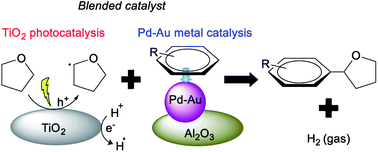Novel blended catalysts consisting of a TiO2 photocatalyst and an Al2O3 supported Pd–Au bimetallic catalyst for direct dehydrogenative cross-coupling between arenes and tetrahydrofuran†
Abstract
Dehydrogenative cross-coupling (DCC) is a clean methodology to make C–C bonds by using abundant C–H bonds. The blended catalyst, developed in this study, consists of a TiO2 photocatalyst and an Al2O3 supported Pd–Au bimetallic catalyst and shows superior activity to the conventional TiO2 photocatalyst loaded with the corresponding metal co-catalyst for the direct DCC between various arenes and tetrahydrofuran, with concomitant evolution of hydrogen gas. The reactions were done under mild conditions without consuming any oxidising agent or other additional chemicals. This new approach of separating the photocatalyst and the metal catalyst parts allows their independent modification to improve the overall catalytic performance.



 Please wait while we load your content...
Please wait while we load your content...